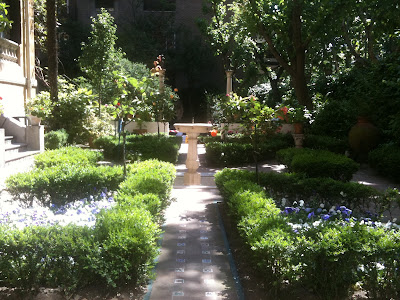And if I lay out my map, I have to concede that the proportion of tiny streets to green does look pretty high. A rough count on Googlemaps view, offers up around 32 listings of parks. I haven't been able to whizz round all of them - a challenge for another time. But I have revisited old memories of the city and found new greenery.
Of course, I went to the Retiro Park - the green heart of the city and the perfect hub on Sundays (when shops are still mostly closed and the city is at leisure) for all the runners, rollerskaters, dogwalkers, promenaders and the overspill from the museums. The Parque del Ouest attracts a similar crowd, but fewer tourists as it's more of a neighbourhood park, but quite a special one, with a small Egyptian temple and a great monument to the Spanish Civil War.
The Botanic Gardens are a more peaceful retreat and a must for the plant geek like me - I love a garden with labels. I like to secretly test my knowledge (and scare myself that my memory is going to pot) and then spot a new plant I've never come across before. I didn't know that botanists have split sedums into two groups and the familar garden varieties, Autum Joy etc are now Hylotelephium. And the Abelia triflora impressed me with it's gorgeous spiced jasmine scent produced by tiny flowers. Meanwhile the English Border - that would be in full sun at home, is in semi-shade, as those familiar perennials would fry in the hot bright Madrid sunshine.
Shade is what Madrid's green spaces do so well, from the long tree-lined boulevards with towering plane and horse chestnut trees, to the paths and grassy areas in the parks - all creating delicious cool wells of space to provide a retreat from the heat. And if I thought that English gardeners were masters of clipped and pruned hedging, I may have to revise this judgment too. Smaller green pleasures this trip have been the abstract hedging outside the Prado in the picture above and this example of high baroque cloud pruning in the Retiro.
But perhaps my favourite discovery was the pretty andalucian style courtyard designed by the painter Sorolla at his house, now a museum. He's a wonderful painter - fantastic light in his work. And the one plant label in this garden told me that the Spanish common name for Cercis Siliquastrum, the judas tree, is Arbol del Amor - tree of love.







Some difference between 'Judas Tree' and 'Tree of Love'!
ReplyDeleteThat cloud pruning - I've never seen anything like it. It looks a bit grim to me but incredibly clever. Is it really as big as it looks - I mean, that is a real bench is it, in its shade?
Esther
Hi Esther - Yes, that is a bench underneath the cloud pruned yew! The trees must have been at least 25ft tall. I don't think my picture did them justice (I was travelling light and just used my iphone), but there was another group across from this one, and in the middle of this large open space these two pools of shade were really quite dramatic. And I too wondered how we chose such a negative name for the cercis...
ReplyDelete